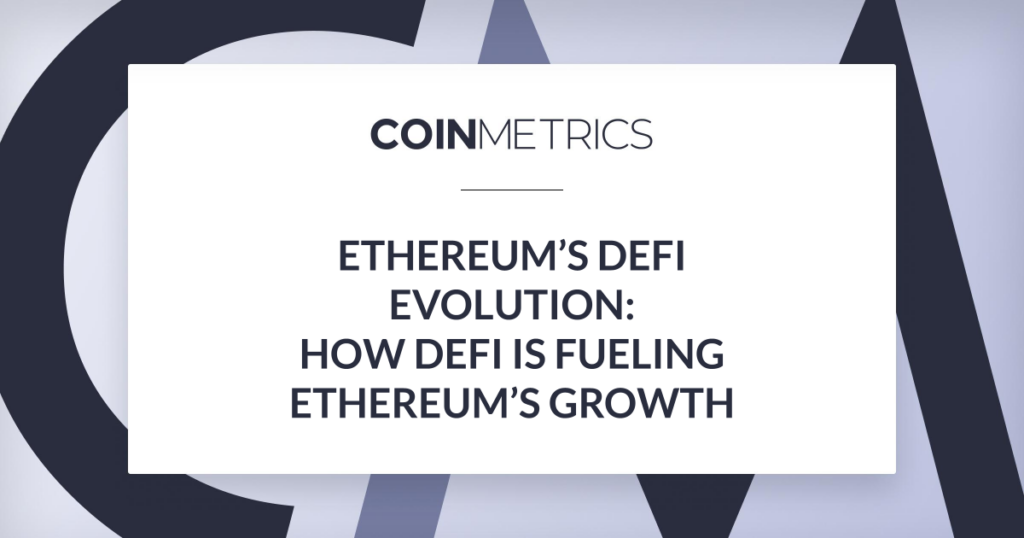Decentralized finance reached new heights over the last few months as dozens of projects launched and large amounts of capital flowed in. A majority of decentralized finance (DeFi) apps have been built on Ethereum, and DeFi’s explosion has rippled across the network. DeFi has pushed Ethereum to its limits but is also accelerating the pace of innovation and experimentation. In this piece we look at how four DeFi token launches affected Ethereum and how the network is evolving as a result.
DEX Dominance
The rise of DeFi has brought on a wave of new tokens including some breakouts. The start of ETH’s summer bull run coincided with the launch of yearn.finance’s governance token YFI. But there have also been some big collapses, like the rapid rise and fall of the YAM token. The below chart shows ETH’s price following four of the largest DeFi token launches to date: YFI, YAM, SUSHI, and UNI.
Source: Coin Metrics Reference Rates
Uniswap, the largest decentralized exchange (DEX) on Ethereum, has been the engine for DeFi token trading. Uniswap trading volume has increased from about $1M a day in early June to close to $1B a day in the beginning of September. Unlike centralized exchanges like Coinbase or Binance, Uniswap trading occurs entirely on-chain. This means that transactions must be sent and settled on Ethereum each time a Uniswap trade is made. On-chain trading has quickly become one of Ethereum’s biggest use cases.
With the rise of Uniswap and other DeFi dapps the amount of Ethereum smart contract calls hit new all-time highs over the summer. Tokens moving around the ecosystem are increasingly controlled by code, creating a whole new level of efficiency and opportunities for automation. But it also introduces more complexity, as DeFi smart contracts can interact with each other and automatically route tokens through multiple platforms.
Source: Coin Metrics Network Data Pro
Another result of DEX growth is the rise of wrapped ETH. Wrapped ETH (WETH) is basically a way to use ETH as an ERC-20 token. DeFi tokens are built on Ethereum’s ERC-20 token standard, which makes it easy to exchange one token for another. But the ERC-20 token standard was introduced after ETH was launched, which means ETH itself does not abide by these standards. To create WETH, ETH is locked up into a smart contract in exchange for WETH tokens.
WETH supply has soared to new all-time highs following the launch of YFI.
Wrapped BTC (WBTC) supply has also been growing with DeFi. WBTC is similar to WETH, except BTC is locked up in exchange for the WBTC ERC-20 token instead of ETH. WBTC can then be used in various DeFi apps like Uniswap and Curve Finance. As WBTC grows, hundreds of millions of dollars are effectively being transferred from Bitcoin into the Ethereum ecosystem, at least temporarily.
Whale Sightings
Ethereum transaction fees have also changed dramatically, as high gas prices are becoming the new norm.
The median ETH transaction fee shot up following the launch of YFI, YAM, SUSHI, and UNI. As new tokens are launched, people race to get in early and trade them on Uniswap and other decentralized exchanges. Since Uniswap trades occur on-chain, a transaction fee must be paid each time a trade is made. The higher transaction fee a user pays (i.e. higher gas price) the higher likelihood that miners will prioritize the transaction, leading to a faster confirmation time. This can lead to escalating transaction fees as users compete to be first in line for a trade.
ETH median transaction fee hit a new all-time high of $8.25 on September 2nd following the launch of SUSHI.
Source: Coin Metrics Network Data Pro
Blockchain transaction fees are a double-edged sword. The fees are ultimately paid to miners, so high total fees create more incentive to secure the Ethereum blockchain. Ethereum miner revenue hit new highs over the summer due to the rise in fees, and as a result Ethereum hash rate is climbing towards all-time highs. This is a good sign for Ethereum, as network security is critical for the long-term health and success of the blockchain.
Source: Coin Metrics Network Data Pro
But high fees can also make it prohibitively expensive for some users to send transactions. Fees are not proportional to the amount of value transferred – sending $100 or $100K would cost the same amount of ETH in fees. Therefore high fees tip the scale towards whales and users who are transferring relatively large amounts, while making it harder to turn a profit investing small sums.
Ethereum’s median transfer value has increased to hundreds of dollars since the rise of DeFi, signalling that the network is shifting towards larger players.
Source: Coin Metrics Network Data Pro
The Next Layer
However, things could soon tip back towards a more even playing field. The rapid rise of DeFi is also pushing a new wave of innovation. Since the summer, organizations throughout the Ethereum ecosystem have gone into overdrive to try to address some of the scalability issues that contribute to high fees.
Last Friday, there was a potentially large milestone in Ethereum’s quest for scalability: the launch of the Optimistic Ethereum Testnet. Optimistic Ethereum is a Layer 2 project that is aiming to create nearly instantaneous Ethereum transactions at a fraction of the cost. It works natively with current Ethereum infrastructure and smart contracts, making adoption easier than many other scalability options. Popular DeFi app Synthetix is offering incentivized usage of the testnet and planning to transition onto Optimistic Ethereum. Uniswap and Chainlink have also signed on to be early adopters.
DeFi will undoubtedly continue to push Ethereum’s limits, as new dapps and tokens launch. But Ethereum is changing as well, and Layer 2 scalability could open up new doors for what is possible in DeFi and beyond.



